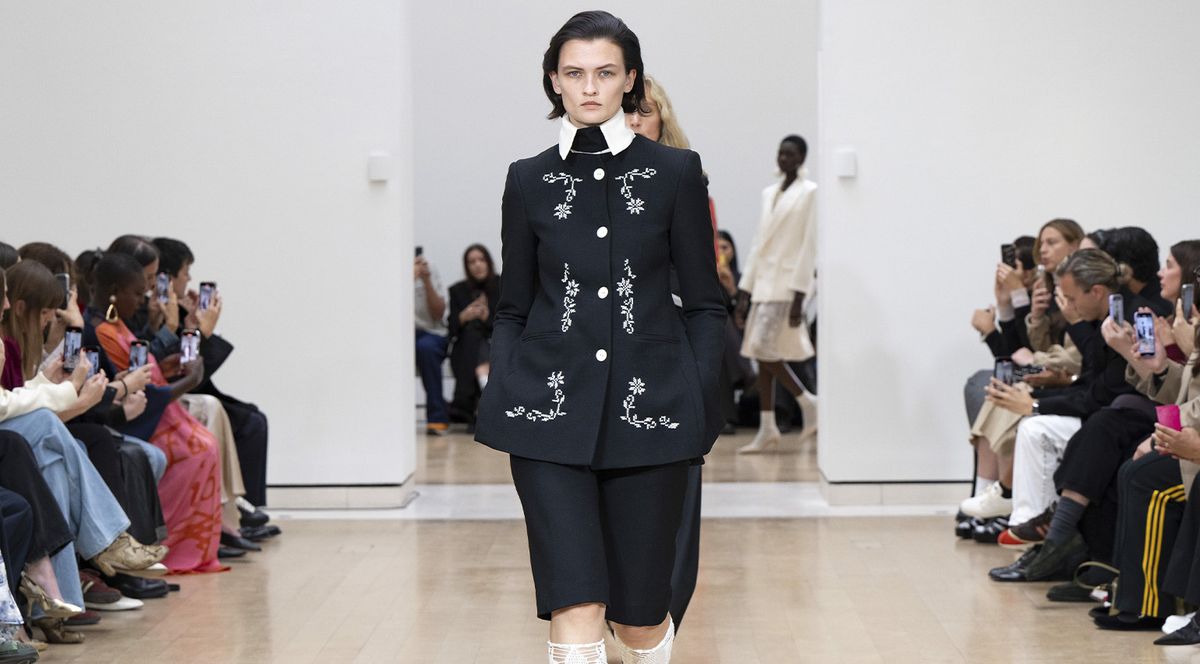While there remains much chatter about the difficulties of founding – and indeed maintaining – a young label in London, the expansive schedule, with shows running from early morning until late into the evening, is proof that London Fashion Week remains buoyant four decades on, even if a few familiar names are missing from the line-up (this year marks the week’s 40th anniversary).
When it comes to young talent, there is plenty in the mix: the Harry Styles-invested label S.S. Daley has already shown its first dedicated womenswear collection, on Friday afternoon; LVMH Prize winner Nensi Dojaka will return to the schedule and debut a collaboration with American behemoth Calvin Klein; while Michael Stewart’s Standing Ground will hold its first solo show after graduating Fashion East. More new-generation talent comes from Chopova Lowena, Paolo Carzana and Aaron Esh, the latter working with stylist Katy England – a close collaborator with Lee Alexander McQueen – for the first time.
Elsewhere, eyes will no doubt be on the week’s two biggest draws – JW Anderson and Burberry, on Sunday and Monday respectively. The latter will take place at Southbank’s National Theatre, including a set created for the occasion by the British artist Gary Hume. Meanwhile, stalwarts of the week Simone Rocha, Roksanda and Erdem will round out the schedule.
Here, reporting live from London, Wallpaper* fashion features editor Jack Moss picks the very best of London Fashion Week S/S 2025, updated as it happens.
The best of London Fashion Week S/S 2025
Derrick
(Image credit: Courtesy of Derrick)
There is something compelling about the relative subtlety of Luke Derrick, an outlier on a London schedule which tends to favour the bombastic and the outré in its young designers. A graduate of London’s Central Saint Martins who went on to work at houses like Brioni, Dunhill and Alexander McQueen, his parlance is tailoring, twisting the traditional medium in intriguing ways, whether through the gentle shift of a collar placement or the choice of fabric, which are often ultra-lightweight and drawn from sportswear (here, he used Japanese nylons). This season – the designer’s sophomore runway show on the fashion week schedule – was titled ‘Raincheck’, seeing Derrick imagine his protagonist for the season having let summer pass him by: ‘newly bought shirts meant for warmer climes, now without purpose… still in London, still caught in the August rain.’ One senses that the true details of these clothes will reveal themselves on closer inspection (Derrick noted that he wanted the surfaces of the fabric to glisten as if misted with dew), though the immediate effect was one of wistfulness – a moment of contemplation amid the fashion week noise.
Fashion East
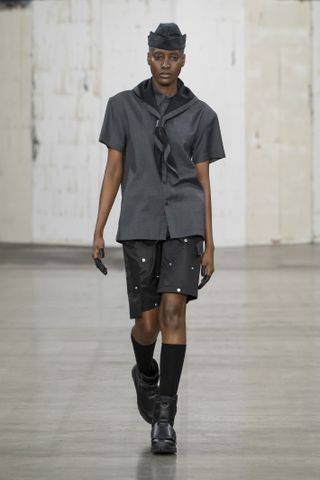
(Image credit: Courtesy of Fashion East)
Fashion East has more than earned its stripes as an incubator of London’s fashion talent (the roster of names which have passed through the Lulu Kennedy-led scheme include Kim Jones, Jonathan Anderson and Grace Wales Bonner). Of the five fledgling labels showing this season, only one, Olly Shinder, had shown with Fashion East previously. His experience showed with a cohesive collection which continued to explore how ‘unspectacular things [can] become objects of urgent desire’ – notably, uniforms and workwear. This season, he titled the collection ‘Summer Camp’, putting his clubwear-inspired spin on PE kits, Scout uniforms and wading gear, reimagined in rubber and nylon. Intricate pattern-cutting, meanwhile, led to cage-like constructions which exposed the skin beneath – a process Shinder says is ‘obsessive’. It had a heady, fetishistic air, an evolution of what Shinder describes as the ‘study and subversion of hypermasculine dress codes’.
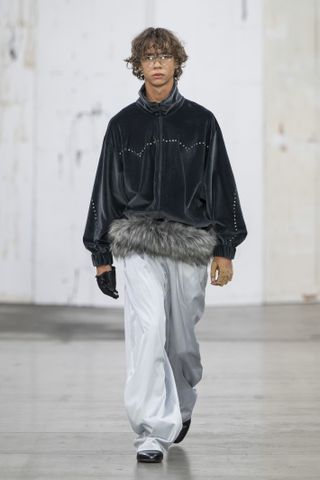
(Image credit: Courtesy of Fashion East)
If Shinder’s clothing is not for the faint of heart, Loutre – the London-based label of former industrial and product designer Pia Schiele – provided a real-world alternative. There was a particular charm to her pieces, which combined louche silhouettes (fluid satin trousers, warped shirting, thick wrapped cummerbunds) with flourishes of embellishment and surface interest, from dots of studs to strips of faux fur. Schiele said she imagined the ‘thrill of running through the city with messy hair and unfinished make-up’, and there was a pleasurable imperfection to the collection’s raw-cut hems and pieced-together styling. Finishing the runway lineup (the other two labels, Positive Energy Flows Again by Kitty Shukman and SOS SKYN held presentations prior to the main show) was Cameron Williams and Jebi Labemika’s Nuba, which draws on the ‘geographies of London, Jamaica and Cameroon’, their respective heritages. Sinuous, twisting silhouettes and low-slung trousers, in which models stuffed their hands, were a metaphor, said the designers, for the sometimes uncomfortable attempts to fit into the pervasive culture, ‘the emotional anguish caused by the need to simulate differing versions of ourselves between alternate realities’. It was an intriguing start.
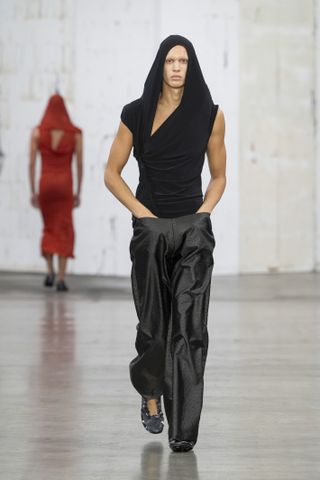
(Image credit: Courtesy of Fashion East)
S.S. Daley
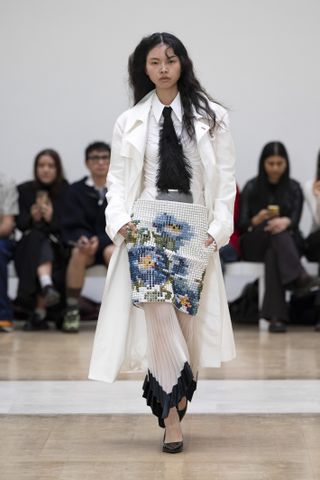
(Image credit: Courtesy of S.S. Daley)
The not-so-surprise guest for S.S. Daley’s first dedicated womenswear outing, shown in an upper gallery of Royal Academy of Arts on Friday afternoon, was the popstar Harry Styles, who was also the runway show’s final arrival. Not so surprising because Styles, a longtime wearer of Steven Stokey-Daley’s eponymous label, invested in the business earlier this year. Taking his seat next to Anna Wintour (who wore a red, white and blue Kamala Harris scarf for the occasion), he was no doubt satisfied with his business decision – this was arguably Daley’s most refined collection yet. Because, while the designer’s fascinations with the traditions and idiosyncrasies of the English class system – often hovering around the Bloomsbury era and its protagonists – have occasionally veered into the realm of costume, here was a considered, real-world offering for a woman’s wardrobe, with just enough of his more outré flourishes to keep it interesting.
The inspiration point this season was the British artist Gluck, the carefully constructed identity of artist and painter Hannah Gluckstein, who rose to prominence in the 1920s and 1930s. A proponent for masculine dress who was openly queer, her subjects – like the florist Constance Spry, who inspired the colourful floral display at the end of the runway – were often the opposite, favouring the blousy, feminine codes of the era. It was a juxtaposition that Daley mined throughout the collection, shifting from masculine nipped-waist tailoring, worn with shorts or voluminous pants, to sinuous bias-cut dresses and beaded floral motifs. ‘Gluck used clothing to curate their identity, then observed the fashion of a lifetime of lovers,’ said Daley. ‘This collection is about the universe around Gluck, allowing us to go deep into the techniques of womenswear. As with our men’s collections, every piece matters, designed to create a full wardrobe.’
Stay tuned for more from London Fashion Week S/S 2025.

